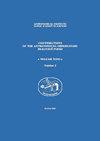K是SUPERWIDE星表中9万颗附近的宽双星中的三颗和四颗矮星
IF 0.2
4区 物理与天体物理
Q4 ASTRONOMY & ASTROPHYSICS
Contributions of the Astronomical Observatory Skalnate Pleso
Pub Date : 2020-04-06
DOI:10.31577/caosp.2020.50.2.446
引用次数: 0
摘要
SUPERWIDE星表是一个包含9万颗宽双星的全天空星表,预计轨道间距为100至100,000 AU,大部分位于距离太阳500pc以内。它们由高自动恒星(> 40 mas/yr)的共自动(CPM)对组成。根据Gaia数据发布2 (DR2)的位置、固有运动和距离进行的贝叶斯分析显示,这些对具有> 99%的引力束缚系统的概率。在这里,我们研究了K+K宽双星,它允许容易地识别未解析的高阶系统,因为K矮星主序列很窄,未解析的子系统很容易被识别为过亮。我们发现980个系统中至少有一个宽分量过亮,这意味着它们是高阶系统(三倍和四倍)。虽然金属丰度效应通常使超亮恒星的识别复杂化,但我们表明,这可以很容易地在宽双星中得到解释,使未解析子系统的识别相对简单。考虑到这些影响,我们计算出高阶多重分数为39.6%。本文章由计算机程序翻译,如有差异,请以英文原文为准。
K dwarf triples and quadruples in the SUPERWIDE catalog of 90,000 nearby wide binaries
The SUPERWIDE catalog is an all-sky catalog of ∼90,000 wide binaries with projected orbital separations ∼100 to 100,000 AU, mostly located within 500 pc of the Sun. These consist of common proper motion (CPM) pairs of high proper motion stars (> 40 mas/yr). A Bayesian analysis using positions, proper motions and distances from Gaia Data Release 2 (DR2) shows these pairs to have probabilities > 99% of being gravitationally bound systems. Here, we examine K+K wide binaries, which allow for easy identification of unresolved higher-order systems because the K dwarf main sequence is narrow and unresolved subsystems are easily identified as over-luminous. We found 980 systems where at least one of the wide components is over-luminous, which means they are higher-order systems (triples and quadruples). Although metallicity efffects generally complicate the identification of over-luminous stars, we show that this can be easily accounted for in wide binaries, making the identification of unresolved subsystems relatively straightforward. Taking these effects into account, we calculate the higher-order multiplicity fraction to be 39.6%.
求助全文
通过发布文献求助,成功后即可免费获取论文全文。
去求助
来源期刊
CiteScore
1.10
自引率
20.00%
发文量
4
审稿时长
>12 weeks
期刊介绍:
Contributions of the Astronomical Observatory Skalnate Pleso" (CAOSP) is published by the Astronomical Institute of the Slovak Academy of Sciences (SAS). The journal publishes new results of astronomical and astrophysical research, preferentially covering the fields of Interplanetary Matter, Stellar Astrophysics and Solar Physics. We publish regular papers, expert comments and review contributions.

 求助内容:
求助内容: 应助结果提醒方式:
应助结果提醒方式:


